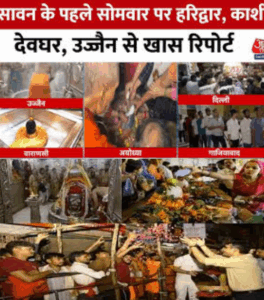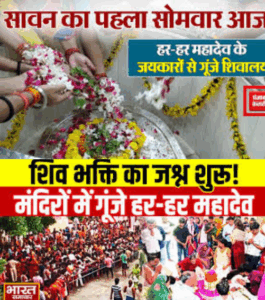Sawan Somwar 2025: From Varanasi to Ayodhya, on the first Monday of Sawan, queues of devotees in Shiva temples
The holy month of Sawan holds a profound spiritual significance in Hinduism, especially for devotees of Lord Shiva. Mondays during this month, known as Sawan Somwars, are considered highly auspicious for offering prayers and performing rituals to please Lord Shiva. In Ayodhya, one of India’s most ancient and sacred cities, thousands of devotees gather at the revered Nageshwar Nath Mahadev Temple to offer Jalabhishek, seek blessings, and fulfill their heartfelt wishes. This year, the fervor was unparalleled on the first Monday of Sawan, as pilgrims from across India, particularly from Bihar and Uttar Pradesh, came together in a powerful expression of faith, tradition, and collective devotion.
The day began early, even before sunrise. By 4:00 AM, the temple gates were opened, and devotees, many of whom had traveled on foot for miles carrying Kanwar Yatras filled with sacred water, started entering the shrine. The atmosphere was charged with chants of “Har Har Mahadev” echoing through the temple complex and surrounding streets. Despite the massive crowd, there was remarkable discipline. People stood in long queues, patient and orderly, waiting their turn to pour holy water and offer Belpatra, Dhatura, honey, milk, curd, sugar, ghee, and seasonal fruits at the Shivling.
One of the most touching aspects of the day was the heartfelt reverence and emotion in the voices of devotees. A group of twenty pilgrims from Bihar, beaming with spiritual joy, shared their journey. “We come here every year. No matter how long or hard the journey is, when we get the darshan of Bholenath, all fatigue disappears. The arrangements this time are even better despite the temple undergoing some construction work. The police and administration have managed the crowd very well,” said one pilgrim with folded hands and a smiling face.

Many others expressed similar sentiments. A man from Jalalpur, who had been visiting the temple for six to seven consecutive years, described how he and his fellow devotees took a ritual bath, collected Gangajal, and walked barefoot to the temple. “This is a 600-year-old self-manifested Shivling. Anyone who prays here with a pure heart never returns empty-handed,” he said. The temple, believed to have been established by Luv or Kush, sons of Lord Rama, is steeped in mythological and spiritual significance. According to temple priests, King Dashrath had once worshipped here and performed Rudrabhishek to seek progeny, which eventually resulted in the birth of Lord Rama and his brothers.
As the day progressed, the temple grounds swelled with waves of devotees. The steady rhythm of drums, the echo of conch shells, and the fragrance of incense created a divine ambiance. Volunteers and security personnel worked hand in hand, ensuring smooth movement, guiding the pilgrims, and providing drinking water and first-aid. The local administration had left no stone unturned. From police officers to district magistrates, all were actively involved in crowd management. Special arrangements had been made to ensure women, children, and elderly people could perform their rituals safely.
By midday, over 50,000 devotees had already completed their darshan. Still, thousands continued to arrive. Many waited for hours but had no complaints. “We are blessed to be here,” one elderly woman said. “We’ve brought Bel leaves, Dhatura flowers, and ghee to offer to Mahadev. I prayed for peace in the world, for my children’s health, and for harmony in our community.”
Another significant feature of the Sawan Somwar observance in Ayodhya is the ritualistic bathing and procession. Devotees often begin their journey from sacred water sources, bathe, collect water in Kanwars, and walk for miles singing devotional songs. Upon reaching the temple, they offer the water as Jalabhishek to the Shiva Lingam. These rituals are not only acts of devotion but also symbolize purification of the body and mind.

Devotees also highlighted how the pilgrimage renews their faith and inner strength. “Lord Shiva is the most generous. He listens to the calls of his devotees. Whatever we wish with true heart, he grants,” said a youth who came walking from a nearby district. “Even in the heat and crowd, our spirit doesn’t break. There’s something divine in the air here during Sawan.”
Beyond the spiritual, the event also highlights the cultural fabric of India—where community living, cooperation, and devotion blend seamlessly. Temporary stalls offering fruits, religious items, and food lined the temple path. Many locals volunteered to serve food and water for free, considering it a form of seva or service to God. These gestures of kindness and hospitality further elevated the sense of sacredness in the gathering.
The temple’s priests and caretakers remained busy throughout the day, guiding pilgrims, performing continuous Rudrabhisheks, and maintaining the spiritual decorum. “Since midnight, we have been performing rituals. The energy here is something you have to experience to understand. The Shivling here is believed to have miraculous powers. That’s why people come from such long distances,” said one of the head priests.
While spiritual satisfaction was the primary aim, safety and security were also crucial. The local government ensured tight security, with police, health workers, and disaster management teams deployed. Drone surveillance, medical camps, and public address systems helped manage the crowd effectively.

An interesting and recurring sentiment was the privacy of individual prayers. When asked what they prayed for, many devotees simply smiled and said, “We can’t tell. It’s between me and Bholenath. But whatever we ask with faith, he gives.” This sense of intimate spiritual connection between devotee and deity stood at the core of the day’s events.
As the sun began to set, the crowd slowly thinned. But the energy, devotion, and chants continued. Some devotees stayed back to attend the evening aarti, which marked the culmination of the day’s spiritual journey. The temple bells rang, and the flames of the aarti lamps danced against the dusk sky, casting a golden glow on the ancient walls of the temple. It was a fitting end to a deeply meaningful day for thousands.
In an age increasingly consumed by technology and urban distractions, such deeply-rooted traditions reflect a continuity of culture and faith that transcends time. Whether it’s an elderly couple walking miles with Gangajal, or a young devotee chanting Mahadev’s name through the night, the Sawan Somwar at Nageshwar Nath Mahadev Temple is more than a religious observance—it is a living testimony to India’s spiritual resilience and collective hope.
As the first Sawan Monday concluded, the echo of “Har Har Mahadev” lingered in the air. For many, it was not just a ritualistic visit, but a deeply personal moment of spiritual awakening and inner peace. And for those who missed it this time, the promise of next Monday—another sacred opportunity to connect with Mahadev—beckoned warmly from the divine heart of Ayodhya.
Play video :
News
Ahmedabad Plane Crash Update: Plane crash! Pilot’s mistake? What did Air India CEO say?
Ahmedabad Plane Crash Update: Plane crash! Pilot’s mistake? What did Air India CEO say? In the aftermath of the tragic…
Shocking! Kareena Kapoor Attacked and Stabbing Incident after Saif Ali Khan attacked for Robbery!
Shocking! Kareena Kapoor Attacked and Stabbing Incident after Saif Ali Khan attacked for Robbery! In mid‑January 2025, a violent intrusion…
Humaira Asghar’s Postmortrm Report revealed shocking Truth of her Father on her LAST Audio Record!
Humaira Asghar’s Postmortrm Report revealed shocking Truth of her Father on her LAST Audio Record! . . . The Shocking…
Kareena Kapoor badly Attacked & met with an Accident after Saif Ali Khan Attacked !
Kareena Kapoor badly Attacked & met with an Accident after Saif Ali Khan Attacked ! . . . Kareena Kapoor…
Humaira Asghar’s Shocking Postmortrm Report revealed Truth of her Death after her LAST Voice Note!
Humaira Asghar’s Shocking Postmortrm Report revealed Truth of her Death after her LAST Voice Note! The world of entertainment is…
Radhika Murder Case: Radhika’s friend Himanshika reveals the secret of the murder, what did she say about the family?
Radhika Murder Case: Radhika’s friend Himanshika reveals the secret of the murder, what did she say about the family? The…
End of content
No more pages to load












